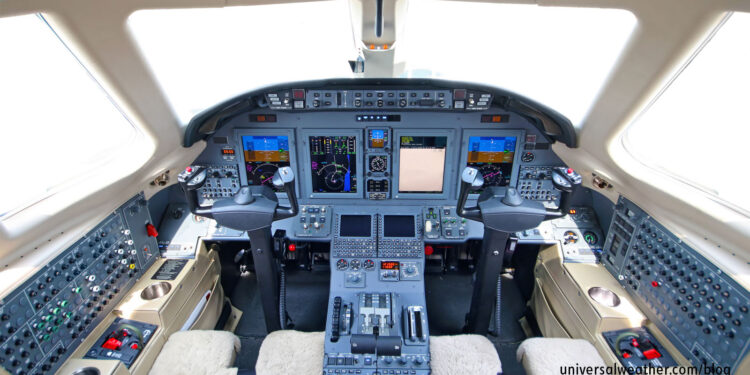Successfully Managing North Atlantic Tracks: Part 2 – Flying the Tracks

This business aviation blog post continues from our article last week, entitled “Successfully Managing North Atlantic Tracks: Part 1 – Track Basics.”
Applying for and revising North Atlantic Track (NAT) authority is a fairly straightforward and user-friendly process. Once you’re on the NATs, there are considerations to be mindful of and rules to be complied with. Some operators, due to performance capability of their particular business aircraft, opt to avoid the NATs altogether – flying above, below, or outside the track system.
The following is an overview of what you need to know:
1. Applying for NAT routings
The first step is to make sure you have the most recent three-digit Track Message Identification (TMI) number for currently published NATs. When you file your flight plan, controllers will want to know what TMI you have. You’ll then be assigned a track. It’s important to ensure that your assigned track matches what you have in your flight plan. Sometimes, a track assignment will be revised by Air Traffic Control (ATC), even when an operator is airborne. You’re required to fly the track that’s been given to you.
2. Revising a NAT
Should you wish to revise or change your NAT, it’s best to work with your 3rd-party provider who can cancel your flight plan and refile it. You may also do this directly/verbally with Shanwick or Gander control with suggested lead time of at least one hour.
3. Optimal routings
NATs are assigned on a first-come-first-served basis. It’s usually best to avoid the core tracks as these can quickly become inundated by scheduled airline demand. It’s recommended to fly ahead or behind the bulk of NAT traffic during peak hours. Many general aviation operators find that their operations are more flexible when using the more outer tracks. The best option for higher-performance aircraft is often to fly above the tracks. Many operators flying above the NAT ask to “shadow” a particular NAT track so that, in case of an emergency, it’s straightforward to descend into a published NAT track.
4. Climbing through RVSM airspace
In most cases if you do not have Minimum Navigation Performance Specification (MNPS) capability, you will not be able to climb or descend through Reduced Vertical Separation Minimum (RVSM) airspace. With sufficient advance planning, however, your 3rd-party provider may be able to arrange an exemption, but you cannot always rely on such exemptions. Even with RVSM and MNPS certification, you’re not permitted to descend through RVSM airspace within non-radar environments if, for example, you wish to land in Greenland.
5. Flying over listed entry/exit points
Be mindful that if you do not fly over the proper NAT entry and exit points, on each side of the Atlantic, you will not have your oceanic clearance uplinked electronically from ATC. In this case you’ll have to call in for your oceanic clearance via voice. Keep in mind that, even if you’re flying a random routing above the tracks, you’ll still need to hit both entry and exit points, or you will not get your oceanic clearance.
6. Penalties for non-compliance
It’s important to be in compliance with all routing authorities – especially when flying the NATs. Gross navigational error penalties come into play if course deviation is 25 NM or more or height deviation is 300 feet or more.
7. Avoiding the NATs
If you’re worried about not making it to altitude, before entering the NATs, you can skirt north of the tracks through Iceland and Gander airspace. The advantage here is that you’re under radar contact most of the way, can climb at your leisure, and won’t be subject to Shanwick NAT nav fees. For operations to/from southern Europe, or between North America and the Middle East, operators may stay south of the NATs by routing via the Azores. You’ll often be able to enjoy better route flexibility and take advantage of lower International Standard Atmosphere temperatures. One negative consideration, however, is that when you head to North America, west of the Azores, Santa Maria (LPAZ) ATC may keep you at low altitudes.
8. Shorter-range aircraft considerations
For operators without RVSM and MNPS certification (typically operators of smaller and shorter-range equipment), it’s possible to fly “Blue Spruce” routes below flight level 290 from Goose Bay (CYYR) over Greenland and to Reykjavik (BIRK). You will still, however, need to be equipped with high-frequency radios as you cannot always rely on nearby aircraft to relay your position reports.
9. Future changes
In a few years – probably before 2020 – current MNPS requirements will end and be replaced by Performance-Based Navigation mandates. Beginning November 2015 a trial will be initiated on the core tracks with reduced lateral separation from 60 nautical miles (NM) to 30 NM which will lead to substantial NAT capacity increase in the future. Auto reporting will one day become standard within NATs with Automatic Dependent Surveillance-Broadcast (ADS-B) equipment requirements. Once ADS-B mandates take effect, we’ll have a positive control environment across the North Atlantic – almost like being in a radar-controlled environment.
07/01/2015: Updated by author
10. Additional reading
For additional information related to this topic, read our series on flight planning on our blog.
Conclusion
The NAT system is a continually evolving operating environment. In the coming years we can anticipate reduced track separation, auto position reporting as a standard, and additional aircraft equipment and certification requirements.
Questions?
If you have any questions about this article or would like assistance with flight planning your next trip, contact me at markmiller@univ-wea.com.



